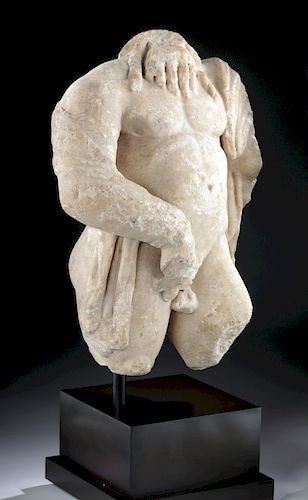Roman Marble Drunken Hercules Urinating
Lot 76b
About Seller
Artemis Fine Arts
686 S Taylor Ave, Ste 106
Louisville, CO 80027
United States
Selling antiquities, ancient and ethnographic art online since 1993, Artemis Gallery specializes in Classical Antiquities (Egyptian, Greek, Roman, Near Eastern), Asian, Pre-Columbian, African / Tribal / Oceanographic art. Our extensive inventory includes pottery, stone, metal, wood, glass and textil...Read more
Estimate:
$20,000 - $30,000
Absentee vs Live bid
Two ways to bid:
- Leave a max absentee bid and the platform will bid on your behalf up to your maximum bid during the live auction.
- Bid live during the auction and your bids will be submitted real-time to the auctioneer.
Bid Increments
| Price | Bid Increment |
|---|---|
| $0 | $25 |
| $300 | $50 |
| $1,000 | $100 |
| $2,000 | $250 |
| $5,000 | $500 |
| $10,000 | $1,000 |
| $20,000 | $2,500 |
| $50,000 | $5,000 |
| $100,000 | $10,000 |
| $200,000 | $20,000 |
About Auction
By Artemis Fine Arts
Sep 26, 2019
Set Reminder
2019-09-26 10:00:00
2019-09-26 10:00:00
America/New_York
Bidsquare
Bidsquare : Exceptional Day 1: Antiquities & Asian Art
https://www.bidsquare.com/auctions/artemis-gallery/exceptional-day-1-antiquities-asian-art-4437
Day 1 of an important 2-day auction featuring exceptional, museum-worthy examples of Egyptian, Greek, Etruscan, Roman, Viking, Russian, Near Eastern, as well as Asian Art from China, Japan, Thailand, Vietnam, Burma and India. Artemis Fine Arts info@artemisfinearts.com
Day 1 of an important 2-day auction featuring exceptional, museum-worthy examples of Egyptian, Greek, Etruscan, Roman, Viking, Russian, Near Eastern, as well as Asian Art from China, Japan, Thailand, Vietnam, Burma and India. Artemis Fine Arts info@artemisfinearts.com
- Lot Description
Roman, Imperial Period, ca. 2nd century CE. An expertly carved marble sculpture of Hercules' torso in the round - inebriated and caught in the act of relieving himself. The sculptor has rendered our hero's body with well-defined musculature and anatomy as well as a lifelike drunken pose. Note how his left leg is advanced and his weight is shifted with a naturalistically arched back, extended abdomen, and a protruding right butt cheek as he holds his genitals to urinate after indulging in too much wine. A cloak likely from the skin of the Nemean Lion he defeated in his first labor is draped over his shoulders. Although the head is missing, we do see the curled tendrils of Hercules' coiffure cascading down his back and those of his beard falling to his chest. Size: 15.94" H (40.5 cm)
Sculptures depicting a drunken Hercules urinating were actually fairly popular in ancient Rome and are generally referred to as Hercules mingens meaning "Hercules pees." This statue was modeled with a Hellenistic philosophy in mind. Hellenistic subjects did not fit the Classical ideal; subjects were oftentimes either very old or very young, disfigured, exhausted (the famous Boxer at Rest in the Museo Nazionale Romano-Palazzo Massimo all Terme), or drunk like this example.
Although most think of Hercules as the strongest of all ancient heroes who met immense challenges, he also enjoyed life and all of its indulgences whenever possible. A man with a strong appetite and very little restraint, Hercules definitely enjoyed fruit of the vine. So it should come as no surprise that he became inebriated from time to time, and following this, needed to relieve himself as we see depicted in this piece.
Provenance: private East Coast, USA collection; ex-German private collection, acquired in the 1980's. Acquired by current owner from German auction house in 2014: Praekolumbische Kunst Kunstwerke der Antike, Munzen und Medaillen, Jubilaumsauktion 300 - 150 Jahre Kunsthandel in der Familie Numismatishe Tradition Seit 1887 - Munich, 24 September 2014.
All items legal to buy/sell under U.S. Statute covering cultural patrimony Code 2600, CHAPTER 14, and are guaranteed to be as described or your money back.
A Certificate of Authenticity will accompany all winning bids.
We ship worldwide and handle all shipping in-house for your convenience.
#149159A torso section from a larger statue. Losses/abrasions to high-pointed areas commensurate with age. Mineral deposits grace the surface.Condition
- Shipping Info
-
All shipping is handled in-house for your convenience. Your invoice from Artemis Gallery will include shipping calculation instructions. If in doubt, please inquire BEFORE bidding for estimated shipping costs for individual items.
-
- Buyer's Premium



 EUR
EUR CAD
CAD AUD
AUD GBP
GBP MXN
MXN HKD
HKD CNY
CNY MYR
MYR SEK
SEK SGD
SGD CHF
CHF THB
THB















